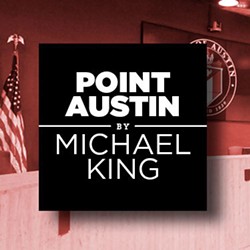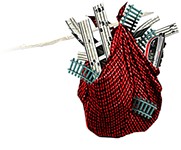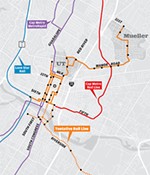Point Austin: From Frontage Road, Texas
Traffic jamming at the Urban Rail Town Hall
By Michael King, Fri., Aug. 29, 2014

It was fitting that Tuesday night's public forum on urban rail occurred in the back room of the Greater Austin Merchants Association's warehouse, a cooperative that caters to convenience stores and gas stations. Located right beside the grand slash of concrete that is Highway 183 N., GAMA is one island of that great expanse of industrialized real estate devoted primarily to the temporary storage of automobiles: one sprawling parking lot after another, accessible only by car, and otherwise useless.
None of the evening's panelists in the Urban Rail Town Hall noted the irony, although before and after I saw several participants uneasily navigating the lot on foot. We're so accustomed to our manufactured dependence on cars – and the staggering waste that it lays to our built landscape – that we barely notice it.
Tuesday night's audience – nearly 200 people – was mostly opposed to the current rail plan and its November bond Proposition 1. That's not surprising, since the event was organized by people opposed to the project, including District 4 City Council candidate Laura Pressley, Mary Rudig of the "Love North Austin" newsletter, and Clint Smith of the local Gray Panthers. The initially announced panel included speakers adamantly opposed to all rail, speakers adamantly opposed to this rail plan – and a Project Connect punching-bag-to-be-named-later.
After apparently significant backstage pushback, the official panel suddenly included a wider range of viewpoints: rail opponents Jim Skaggs and Bill Oakey; Project Connect opponents Scott Morris (subbed Tuesday by Andrew Clements) and Lyndon Henry; and Project supporters Martha Smiley of the Chamber of Commerce, CM Bill Spelman, and Thomas Butler of the Downtown Austin Alliance and Let's Go Austin. The result was a lively discussion, and though it was hard to tell if any minds were changed, by the end it was least possible to imagine progress on Smiley's injunction: "Whether you vote it up or down, you will at least understand what you're voting on."
Best and Worst
The program began with abbreviated presentations by Smiley and Spelman on the nuts-and-bolts of the project – rapid-fire and only occasionally punctuated by crowd reaction (e.g., sarcastic laughter when Spelman described the cost estimates as "probably" high). Smiley noted the costs already associated with transportation (estimated at $13,800/year per family); Butler described the population and work centers to be served by the initial route.
Skaggs, an opponent of all rail projects, called the proposed plan "the worst decision in Austin's history," that would be "a negative for the citizens and community" and reduce the overall quality of life. He insisted the rail would interfere with vehicle traffic, drive residents out of town (despite every current demographic projection), "destroy school enrollment," and "increase growing unaffordability." "We need roads, not rail," Skaggs concluded. "We'll get more service at the same cost."
For Oakey, cost is the sole criteria, and he claimed the bonds would "exhaust" the city's bond capacity and threaten its credit rating. ("I don't know where you're getting that," responded Spelman, "because it's just not true.") Clements and Henry (nominally rail advocates) attacked the specific plan, and specifically the route, insisting that Guadalupe/Lamar is the only possible starter route, and that this plan must be voted down, so that (according to Henry) a better one could be approved "in two to four years." Henry insisted his plan would be much cheaper, too, although you had to read his handout to learn that he manages that by discarding both the lake crossing and the entire East Riverside segment.
Get Your Motor Running
Few of the arguments were unfamiliar to anyone following the project. More mysterious was Rudig's subsequent post: "Our community was finally able to ask questions, questions that nobody would answer during Project Connect's 250 public engagements on the East Austin Rail." In fact, nothing was raised that hasn't been publicly discussed many times before.
Moderator Andy Pierrotti of KVUE was adept at keeping everyone reasonably on point. Spelman had to endure some brief guff – but he's unflappable, and no doubt looking forward to January, when he is no longer subject to such cloddish disrespect.
Among the audience were at least a dozen Council candidates, and several spoke against the plan. It was amusing to see both mayoral candidate Todd Phelps and District 3 Council candidate Susana Almanza – very odd bedfellows indeed – argue variations on the "this is old technology," with Almanza even denouncing the "Iron Horse" that destroys "native communities" and affordable housing.
I suppose we should discard roads and wheels as well, since they predate trains by a few millennia, and while we're at it certainly junk the internal combustion engine, because its time has definitely passed.
That's just about where I began. As Smiley reiterated, "We need a workable, multimodal transportation system," "we can't build it everywhere at once," and "we have to start somewhere." Voters will decide in November whether we wish to begin that project, or if we'd rather endure additional decades of those endless – and extremely expensive – parking lots.
Got something to say on the subject? Send a letter to the editor.










